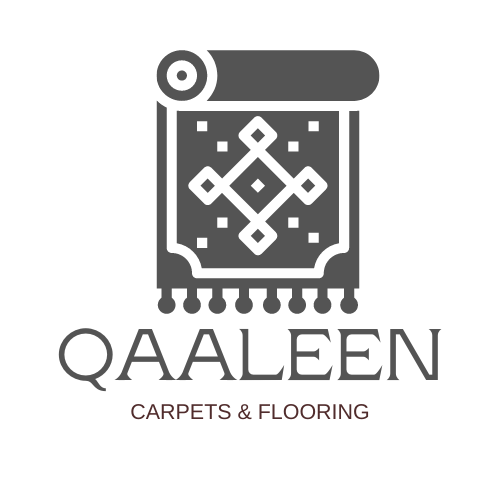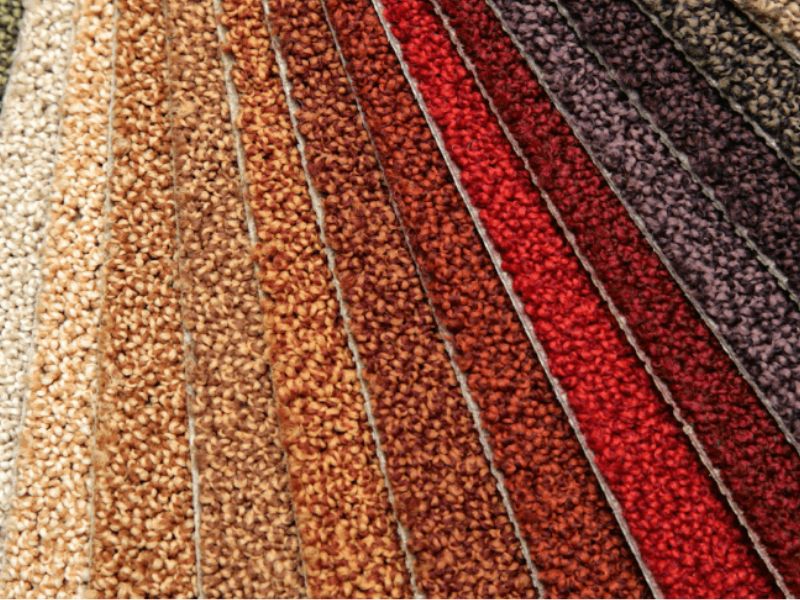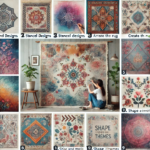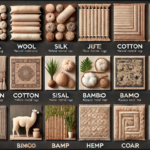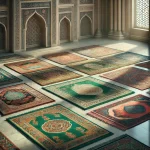Choosing the right carpet for your space involves more than just selecting a color or pattern. Understanding the different construction types can help you make an informed decision that aligns with your needs, lifestyle, and design preferences. From plush piles to looped textures, each construction type offers unique characteristics that contribute to the overall look, feel, and durability of your carpet. Let’s explore the various carpet construction types to help you find the perfect fit for your space.
Cut Pile Carpets
Description: Cut pile carpets feature yarn fibers that are cut at the top, creating a soft and dense surface. This construction type offers a plush feel underfoot and a luxurious appearance.
Advantages:
- Softness: Cut pile carpets provide exceptional comfort and coziness, making them ideal for bedrooms, living rooms, and other areas where comfort is paramount.
- Durability: With proper maintenance, cut pile carpets can withstand heavy foot traffic and maintain their appearance over time.
- Versatility: Available in a wide range of styles, colors, and textures, cut pile carpets offer versatility to suit various design preferences.
Popular Styles: Plush, Saxony, Frieze, Shag
Loop Pile Carpets
Description: Loop pile carpets feature yarn fibers that are looped through the backing, creating a durable and textured surface. This construction type is known for its resilience and resistance to wear.
Advantages:
- Durability: Loop pile carpets are highly resistant to crushing and matting, making them suitable for high-traffic areas such as hallways, entryways, and commercial spaces.
- Ease of Maintenance: The looped construction makes loop pile carpets easy to clean and maintain, as dirt and debris are less likely to become trapped in the fibers.
- Texture: Loop pile carpets offer a unique texture and visual interest, adding depth and dimension to your space.
Popular Styles: Berber, Level Loop, Multi-Level Loop
Cut and Loop Pile Carpets
Advantages:
- Design Versatility: Cut and loop pile carpets allow for the creation of intricate patterns, geometric designs, and textural variations, adding visual interest to your space.
- Stain Resistance: The combination of cut and looped fibers can help disguise stains and spills, making cut and loop pile carpets a practical choice for busy households.
- Comfort: Cut and loop pile carpets offer the softness of cut piles with the durability of loop piles, providing a comfortable and resilient surface underfoot.
Popular Styles: Sculpted, Patterned, Carved
Carpet Tiles
Description: Carpet tiles are individual squares of carpet that can be installed separately, allowing for easy replacement and customization. This construction type offers flexibility and versatility.
Advantages:
- Modularity: Carpet tiles can be arranged in various patterns and configurations, allowing for endless design possibilities.
- Ease of Installation: Carpet tiles are simple to install and can be replaced individually if damaged, minimizing downtime and maintenance costs.
- Durability: Carpet tiles are typically made from durable materials and are resistant to staining, making them suitable for high-traffic areas and commercial spaces.
Popular Styles: Solid, Patterned, Modular
Choosing the right carpet construction type for your space requires careful consideration of factors such as durability, comfort, and design aesthetics. Whether you prefer the softness of cut pile carpets, the resilience of loop pile carpets, or the versatility of carpet tiles, there is a construction type to suit every need and preference. By exploring the various options available, you can find the perfect carpet for your space that combines style, functionality, and durability for years to come.
A Comprehensive Guide
Selecting the perfect carpet for your space involves more than just picking out a color or pattern. Understanding the different carpet construction types can help you make an informed decision that suits your lifestyle, design preferences, and practical needs. From plush piles to looped textures, each construction type offers distinct characteristics that contribute to the overall look, feel, and performance of your carpet. Let’s delve deeper into the world of carpet construction to help you find the ideal fit for your space.
Cut Pile Carpets
Advantages:
- Comfort: Cut pile carpets provide exceptional comfort and coziness, making them perfect for areas where relaxation is key, such as bedrooms and family rooms.
- Durability: With proper maintenance, cut pile carpets can withstand heavy foot traffic and maintain their appearance over time.
- Versatility: Available in various styles, including plush, Saxony, frieze, and shag, cut pile carpets offer versatility to complement a wide range of interior design schemes.
Loop Pile Carpets
Description: Loop pile carpets feature yarn fibers that form loops throughout the carpet’s surface, creating a durable and textured appearance. This construction type is renowned for its resilience and resistance to wear.
Advantages:
- Durability: Loop pile carpets are highly resistant to crushing and matting, making them suitable for high-traffic areas such as hallways, stairs, and commercial spaces.
- Low Maintenance: The looped construction makes loop pile carpets easy to clean and maintain, as dirt and debris are less likely to become trapped in the fibers.
- Texture: Loop pile carpets offer a unique texture and visual interest, adding depth and dimension to your space.
Cut and Loop Pile Carpets
Description: Cut and loop pile carpets combine both cut and looped fibers to create intricate patterns and textures. This construction type offers a blend of softness and durability, making it a popular choice for residential and commercial settings.
Advantages:
- Design Versatility: Cut and loop pile carpets allow for the creation of intricate patterns, geometric designs, and textural variations, adding visual interest to your space.
- Stain Resistance: The combination of cut and looped fibers can help disguise stains and spills, making cut and loop pile carpets a practical choice for busy households and high-traffic areas.
- Comfort: Cut and loop pile carpets offer the softness of cut piles with the durability of loop piles, providing a comfortable and resilient surface underfoot.
Carpet Tiles
Advantages:
- Modularity: Carpet tiles can be arranged in various patterns and configurations, allowing for endless design possibilities.
- Easy Installation: Carpet tiles are simple to install and can be replaced individually if damaged, reducing downtime and maintenance costs.
- Durability: Carpet tiles are typically made from durable materials and are resistant to staining, making them suitable for high-traffic areas, commercial spaces, and areas prone to spills.
When choosing a carpet for your space, consider factors such as durability, comfort, maintenance requirements, and design aesthetics. Whether you prefer the luxurious softness of cut pile carpets, the durability of loop pile carpets, the versatility of cut and loop pile carpets, or the flexibility of carpet tiles, there is a construction type to suit your needs. By exploring the various options available, you can find the perfect carpet that combines style, functionality, and durability for your space.
Selecting the perfect carpet for your space involves careful consideration of several factors, with one of the most crucial being its construction type. The construction determines not only the carpet’s durability and resilience but also its overall appearance and suitability for different areas of your home. By understanding the different types of carpet construction available, you can make an informed decision and choose the ideal carpet for your space. Let’s explore the various carpet construction types and their characteristics to help you make the right choice.
Understanding Different Carpet Constructions
Carpet construction refers to how the fibers are attached or woven together to form the carpet’s structure and texture. Here are the main types of carpet constructions to consider:
Cut-Pile Construction
Description: Cut-pile carpets feature yarn fibers that are precisely cut at the top, resulting in individual, upright tufts. This construction type offers a soft and plush feel underfoot and comes in various textures and styles.
Advantages:
- Comfort: Provides exceptional comfort and coziness, making it ideal for areas where relaxation is essential.
- Durability: With proper maintenance, cut-pile carpets can withstand heavy foot traffic and maintain their appearance over time.
- Versatility: Available in different styles like plush, Saxony, and frieze, catering to various design preferences.
Loop-Pile Construction
Description: Loop-pile carpets are created by weaving yarn in continuous loops, resulting in a durable and textured surface. This construction type is resilient and less likely to show signs of wear.
Advantages:
- Durability: Highly resistant to crushing and matting, making them suitable for high-traffic areas.
- Low Maintenance: Easy to clean and maintain, as dirt and debris are less likely to become trapped in the fibers.
- Texture: Offers a unique texture and visual interest, adding depth to your space.
Cut and Loop Pile Construction
Description: Cut and loop-pile carpets combine both cut and looped fibers to create intricate patterns and textures, offering a blend of softness and durability.
Advantages:
- Design Versatility: Allows for the creation of intricate patterns and textural variations, adding visual interest to your space.
- Stain Resistance: Disguises stains and spills well, making them practical for busy households.
- Comfort: Offers the softness of cut piles with the durability of loop piles, providing a comfortable and resilient surface.
Carpet Tiles
Description: Carpet tiles are individual squares of carpet that can be installed separately, offering flexibility and ease of installation.
Advantages:
- Modularity: Can be arranged in various patterns and configurations, allowing for endless design possibilities.
- Easy Installation: Simple to install and can be replaced individually if damaged, reducing maintenance costs.
- Durability: Made from durable materials and resistant to staining, suitable for high-traffic areas.
Factors to Consider When Choosing a Carpet Construction
When selecting the best carpet for your space, consider the following factors:
- Durability: Choose a carpet construction that can withstand the wear and tear of your space, especially in high-traffic areas.
- Fiber Content: Consider natural fibers like wool for softness or synthetic fibers like nylon for durability and affordability.
- Stain Resistance: Look for carpets with built-in stain-resistant treatments or technologies to repel spills and make cleaning easier.
- Cost: Factor in your budget and the long-term investment value of the carpet.
By considering these factors and understanding the different carpet construction types available, you can confidently choose the perfect carpet for your space that combines style, comfort, and durability.
When it comes to selecting the perfect carpet for your space, numerous factors need to be taken into consideration, with one of the most critical being the carpet’s construction type. The construction not only dictates the carpet’s durability and resilience but also significantly influences its overall appearance and suitability for various areas of your home or office. By delving into the different carpet construction types available, you can make a well-informed decision that aligns with your aesthetic preferences, lifestyle, and practical needs. Let’s embark on a comprehensive exploration of the diverse carpet construction types to help you navigate the selection process effectively.
Understanding the Various Carpet Constructions
Carpet construction refers to the method by which the carpet fibers are woven or attached to form the carpet’s structure and texture. Here’s an in-depth look at the primary types of carpet constructions:
Cut-Pile Construction
Description: Cut-pile carpets feature yarn fibers that are precisely cut at the top, resulting in individual, upright tufts. This construction type offers a plush and luxurious feel underfoot, making it a popular choice for residential and commercial spaces alike.
Advantages:
- Comfort: Provides exceptional softness and comfort, making it ideal for areas where relaxation is paramount.
- Durability: With proper maintenance, cut-pile carpets can withstand heavy foot traffic and maintain their appearance over time.
- Versatility: Available in various styles, including plush, Saxony, and frieze, catering to diverse design preferences and interior aesthetics.
Loop-Pile Construction
Description: Loop-pile carpets are characterized by yarn fibers woven into continuous loops, resulting in a durable and textured surface. This construction type offers excellent resilience and is less prone to showing signs of wear and tear.
Advantages:
- Durability: Highly resistant to crushing and matting, making it suitable for high-traffic areas such as hallways, stairs, and commercial spaces.
- Low Maintenance: Easy to clean and maintain, as dirt and debris are less likely to become trapped in the looped fibers.
- Texture: Offers a unique texture and visual interest, adding depth and dimension to your space.
Cut and Loop Pile Construction
Description: Cut and loop-pile carpets combine both cut and looped fibers to create intricate patterns and textures, offering a blend of softness and durability.
Advantages:
- Design Versatility: Allows for the creation of intricate patterns and textural variations, adding visual interest and sophistication to your space.
- Stain Resistance: Disguises stains and spills effectively, making it practical for households with pets and children.
- Comfort: Offers the plush softness of cut piles with the durability and resilience of loop piles, providing a comfortable and resilient surface.
Carpet Tiles
Description: Carpet tiles, also known as modular carpet, are individual squares of carpet that can be installed separately, offering flexibility and customization options.
Advantages:
- Modularity: Allows for creative arrangements and configurations, enabling endless design possibilities to suit your space.
- Ease of Installation: Simple to install and replace individually if damaged, reducing downtime and maintenance costs.
- Durability: Made from durable materials and resistant to staining, making them suitable for high-traffic areas and commercial spaces.
Key Factors to Consider When Choosing a Carpet Construction
When selecting the ideal carpet construction for your space, several key factors should be taken into account:
- Durability: Consider the level of foot traffic in the area and choose a carpet construction that can withstand heavy use without showing signs of wear and tear.
- Fiber Content: Evaluate the fiber type, whether natural (e.g., wool) or synthetic (e.g., nylon, polyester), based on factors such as softness, durability, and budget.
- Stain Resistance: Look for carpets with built-in stain-resistant treatments or technologies to repel spills and make cleaning easier, especially in high-traffic areas or households with pets and children.
- Aesthetic Appeal: Consider the overall design aesthetic and ambiance you wish to create, selecting a carpet construction that complements your interior decor and enhances the visual appeal of your space.
By carefully considering these factors and understanding the nuances of different carpet construction types, you can make a well-informed decision that results in a carpet that not only enhances the beauty of your space but also meets your functional and practical requirements effectively.
